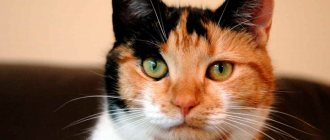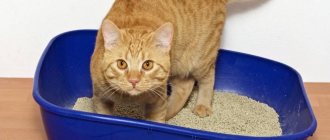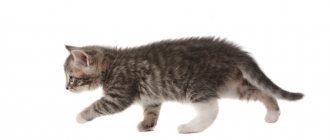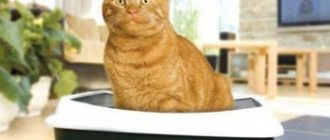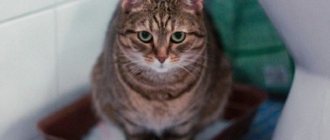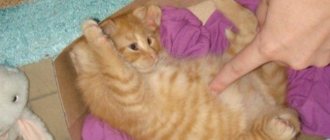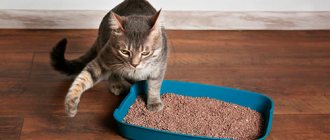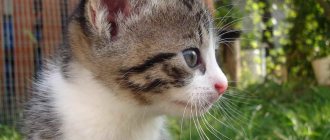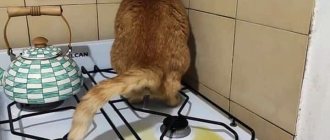Stool retention in domestic cats occurs quite often. Therefore, owners of furry pets should be able to diagnose this ailment and know how to combat constipation. A large intestine filled with feces not only causes suffering to the cat, but also leads to poisoning of the animal’s entire body. If the disease persists, constipation in a cat can result in the death of the pet. To prevent the disease from becoming severe, veterinarians recommend keeping laxatives (bisacodyl, duphalac) in your home medicine cabinet.
Constipation symptoms
The average domestic cat defecates once a day. A delay of up to 12 hours is acceptable, after which the owner must begin to take action. The appearance of normal excrement is dense and well-formed. With constipation, the feces are dry, cracked, or pea-shaped (like a goat's). An attentive pet owner monitors the condition of the cat's litter box in order to receive timely information if the pet is ill. If there is no stool for a period of two days, you should monitor the cat.
If feces stagnate inside the intestines, the stool becomes compacted due to the evaporation of water. The feces become harder and scratch the walls of the large intestine, black in color. In addition, excrement consists of waste products from the body, so the accumulation of feces inside the body leads to intoxication of the animal.
Determine constipation in a cat, signs of constipation:
- No feces in the tray for two days.
- The kitten makes repeated, constant unsuccessful attempts to sit on the tray and cannot poop.
- When trying to fulfill its natural needs, the cat meows plaintively and protractedly.
- The pet is trying to find a new place for the toilet, raking it with its paws, but the process does not go as expected.
In the pathological course of the disease, malaise is accompanied by additional alarming symptoms. The pet's behavior changes. The cat becomes apathetic and lethargic, loses interest in food, and hides in the dark corners of the room. The animal may experience nausea and vomiting. Kitty signals problems with loud screams. The cat's belly becomes rock hard. A sick pet will reject any attempts to touch the tummy, since there is a source of inflammation and pain there. In rare cases, a small amount of discharge with blood and mucus appears. If your pet only produces blood and mucous clots from the anus, you should urgently seek help from a veterinary clinic.
How many days can a kitten go without walking (stress when moving)
Kittens visit the litter box up to 3 times a day. More or less is considered a deviation in the functioning of the digestive tract. The first option (increasing trips to the toilet) indicates poor functioning of the gastric mucosa.
Be sure to read:
How to remove the smell of cat urine from shoes - special means: how to remove and what to do
The second option may be an indicator of more serious problems with the baby’s health:
- inflammation of the gastrointestinal tract;
- adhesive disease;
- hernia and scarring;
- swelling or rupture of the anal canal.
But don't panic ahead of time. Kittens also experience problematic bowel movements after a long trip, weaning from their mother's milk, or when moving to a new home. The pet needs to be given some time to adapt. If after this the animal suffers from constipation, it is necessary to consult a veterinarian.
Causes of constipation, how to understand
The delay in the normal fulfillment of natural needs worsens with age. In an older pet (an elderly cat), the flow of all processes in the body is inhibited. Intestinal peristalsis is weakened and problems arise with removing feces from the animal’s body. Statistics show that male cats suffer from a decrease in the permeability of the intestinal tract much more often than representatives of the weaker half.
Veterinarians name the most common causes of constipation:
- improper diet (table scraps, lack of fiber in food);
- foreign object in the intestines (swallowed foreign object);
- hairball in a British, Scottish cat, Maine Coon;
- reduced physical activity of the pet;
- inflammatory processes in the large intestine;
- helminth infection;
- tumors of the intestinal tract (benign or malignant);
- malformation of the large intestine (megacolon);
- diseases of internal organs leading to inhibition of food digestion processes;
- side effect of the sterilization procedure in neutered cats;
- stress, problems with the nervous system;
- prostate disease in a male;
- consequences of injury.
Laxatives and manipulations
The principles of operation of the drugs with which a cat can empty its intestines are different. Based on the type of effect, medications can be divided into the following groups.
Osmotic
These drugs (give Guttalax, Duphalac) are not emergency medications and are used to normalize regular bowel movements in case of frequent constipation. The principle by which such drugs act is to draw fluid from the body’s cells. Filling with water, feces increase in volume and begin to put intense pressure on the intestinal walls. This process strengthens and makes the urge to empty the bowel more frequent. The active ingredient of the medicine is lactulose. The beneficial effect of this element is also manifested in supporting the proliferation of beneficial bacteria inside the intestines and in suppressing the activity of microorganisms that are dangerous to health. The effect of the drugs occurs one or two days after administration. Medicines are prescribed in case of dysbiosis, but such medicines are prohibited in case of renal failure. Uncontrolled use of osmotic drugs can lead to dehydration of the cat's body.
Volume increase
The principle of action of such volume-forming medications is simple: once inside the intestine, the substance begins to increase in volume due to the water entering the body. To achieve the intended effect, the cat must drink plenty of fluids while taking the medications. The result of the treatment does not manifest itself too quickly: the stool returns to normal within 12 hours to three days.
Lubrication
If a foreign object gets inside the cat’s body, such a mechanical barrier can block the path of normal exit of feces from the intestinal tract. Similar consequences can be caused by a large hairball formed from hair that the cat involuntarily swallows, tidying up its fur. In such a situation, products will help that lubricate the inner surface of the intestines and make it easier for solid objects to slide through the body until the end of their journey. Such medications are commonly called “malt pastes”. As a rule, veterinarians recommend Beaphar, Sanal or Gim-Cat malt paste.
Mitigation
Stool thinning medications allow you to provide your cat with quick help and quickly empty the intestinal tract. Such products are produced in the form of microenemas and act after a period of time from three to five hours. The drugs should not be used for pregnant or lactating females. The veterinarian recommends such dosage forms in cases where constipation threatens to intoxicate the body.
Stimulation
Stimulants act on the muscles of the intestinal tract, causing the muscles to contract frequently and intensely. Cycles of compression and contraction help move stool and remove feces from the animal's body. The duration of action of such laxatives is quite short: the animal is freed from stagnant masses within 6-8 hours. The negative effect of using drugs of this type is that the intestinal tract becomes accustomed to stimulation. If stimulant drugs are used frequently and uncontrollably, this will lead to the fact that the intestines will refuse to function without additional stimulation.
Home Recipes
Cat owners have long noted the effectiveness of certain foods in relieving cats of constipation. In cases where the malaise has not yet reached a difficult phase, you can solve the problem with home remedies. We offer several simple products to help improve your domestic cat's stool:
- Condensed milk. Canned milk from a can should be mixed with water, maintaining a ratio of one to three, and offered to the cat in small quantities several times a day. The time interval between two doses should be at least three hours. It should be remembered that condensed milk is contraindicated in diabetes.
- Vegetable oil. A few drops of oily liquid should be added to your cat's regular food. You can use sunflower, vegetable, olive oil, as well as coconut or flax oil. There is no need to abuse this product, since side effects in the form of negative effects on the animal’s liver are possible. This product is not suitable for kittens.
- Castor oil, Vaseline, how much to give? These pharmaceutical preparations are given to the animal directly into the oral cavity using a special syringe. The dosage is approximately 15 ml per 10 kg of weight. Taking such a medicine will lead to rapid release of the clogged intestinal tract. After the cat swallows the oil, the pet should not be fed until the drug takes effect. If there is no effect within five hours, the procedure can be repeated.
- Fresh milk has a pronounced laxative effect, so this food product should be given to your furry pet in small doses, divided into several servings per day. Excessive consumption of milk will weaken you greatly and lead to diarrhea.
- Squeezed juices and pureed vegetables. The following vegetables rich in fiber have laxative properties: pumpkin, beets, carrots. While playing with your pet, you can offer the cat a piece of one of these root vegetables.
- Healing herbs. A cat walking around a house in a village finds its own medicine without the help of its owner. Useful plants that have a laxative effect: lemon balm, catnip, rhubarb leaf, chamomile, buckthorn, cucumber leaves, aloe. In urban areas, these herbs are purchased at the pharmacy. It is better to consume beneficial flora in the form of an infusion. To prepare one glass of drink, you need to take a tablespoon of crushed natural product. When the drink is infused, the liquid must be cooled and strained. The recommended dosage is a teaspoon every 3-4 hours.
Cleansing enema and massage
Cleansing the intestinal tract through a cleansing enema is an effective way to combat intestinal blockage. This method is the fastest and most reliable, but some experience is required to carry out such a procedure. It is best to entrust cleaning your pet's intestines with an enema to a veterinarian or paramedic.
Chamomile decoction is best suited as a solution for administration using an enema. The temperature of the liquid should be slightly lower than the cat's body temperature in order to achieve the desired effect and not cause pain to the animal.
How to do and administer an enema correctly, the procedure for performing the manipulation:
- Draw into the enema a solution prepared in advance and cooled to the desired temperature.
- Apply lubricant (vaseline oil, linseed oil, castor oil) to the enema tip to facilitate insertion.
- Take the enema in your hands vertically and press slightly on the side until the first drops of liquid appear. Such actions ensure that no air bubble gets into the animal's intestinal tract.
- Using a circular motion, slowly insert the enema into the cat's anus.
- Increasing pressure on the enema, add liquid.
- After removing the device, place the cat's tail against the anus and hold the animal in this position in your arms for 10 minutes until the fecal stones come out.
The enema has a list of contraindications for which this procedure cannot be used:
- damage to the intestinal tract;
- bloody discharge from the anus;
- the pet suffers from heart or vascular disease;
- the cat’s body is infected with parasites;
- a female suffering from constipation is expecting a litter.
Is it possible to give a microlax enema to a kitten - it is not recommended, because... designed for people.
An alternative to an enema is to massage your furry friend's tummy. To carry out such a procedure, a high degree of trust is required in the relationship between the cat and the owner. Stroking should be done in a circle, moving clockwise, avoiding strong pressure.
Kitten training
How to get a kitten to go to the toilet if the previous owners did not teach him to go to the litter box? The main thing is not to get upset. During the day, you should watch your pet and take it to the place where the tray should be located. If the pet made a puddle or something else: for example, a person went into another room for literally half a minute or absent-mindedly missed the moment - then it is imperative to immediately clean up after the baby and clean the area with a strong-smelling detergent (if this is not done, the wrong habit may form) . Cats use their scent to navigate where to go to the toilet, and the kitten will return to this place again and again, rather than go to the litter box.
How to help a kitten with constipation
The kitten's intestines are a vulnerable spot for the baby, because at an early age it does not cope with its functions very successfully. Therefore, newborn kittens, two weeks old, one month old are not immune from constipation. In order to find out the reason for stool retention, the owner needs to contact a veterinarian. You cannot prescribe medication to your baby on your own. The doctor may prescribe harmless syrups or powders for the kitten, which need to be added to the food or injected into the oral cavity using a special syringe. Common medications that improve peristalsis include: Prelax, Lactusan, Vetelakt. The owner of a growing cat can prepare a weak solution of condensed milk for the baby, add a drop of Vaseline oil to the food, or give the baby a belly massage.
Outdoor toilet
How to train a kitten to go to the toilet in a private house? There are two methods to teach your baby to go to the toilet outside using a tray. The first is the gradual development of a habit. The second is the most common, but you need to monitor the animal’s reaction. If the baby looks for a dark corner after feeding, he tries to show that he wants to go to the toilet, in which case he needs to be taken outside. The actions must be repeated so that he can get used to doing his business near the house.
How to make a kitten go to the toilet if he is hiding? Close the doors before feeding, then he will be in sight. You can walk the cat after each feeding and wait for the result. This will have a good effect on digestion. Within a few days, you will develop the reflex to ask to go outside.
Preventing constipation
To avoid the occurrence and development of intestinal blockage in cats, you should adhere to the following rules and recommendations:
- Systematically brush cats with long and thick fur.
- For furry fans of cleanliness who are ready to lick fur all day long, special pastes have been created that are used to dissolve fur inside the gastrointestinal tract. Such pastes should be given on a regular basis to prevent constipation.
- Provide your cat with free access to fresh and clean water.
- Consider the cat's diet so that the animal receives a sufficient amount of fiber.
- Give probiotics for at least a week after antibiotic treatment.
- Lazy cats need to be involved in outdoor games so that the pet does not develop physical inactivity.
- If your cat likes to chew small objects, you should limit the animal's access to dangerous objects that can be accidentally swallowed.
- Every year you need to show your cat to a veterinarian for timely diagnosis of incipient diseases; I would like to prevent the disease rather than cure it.
